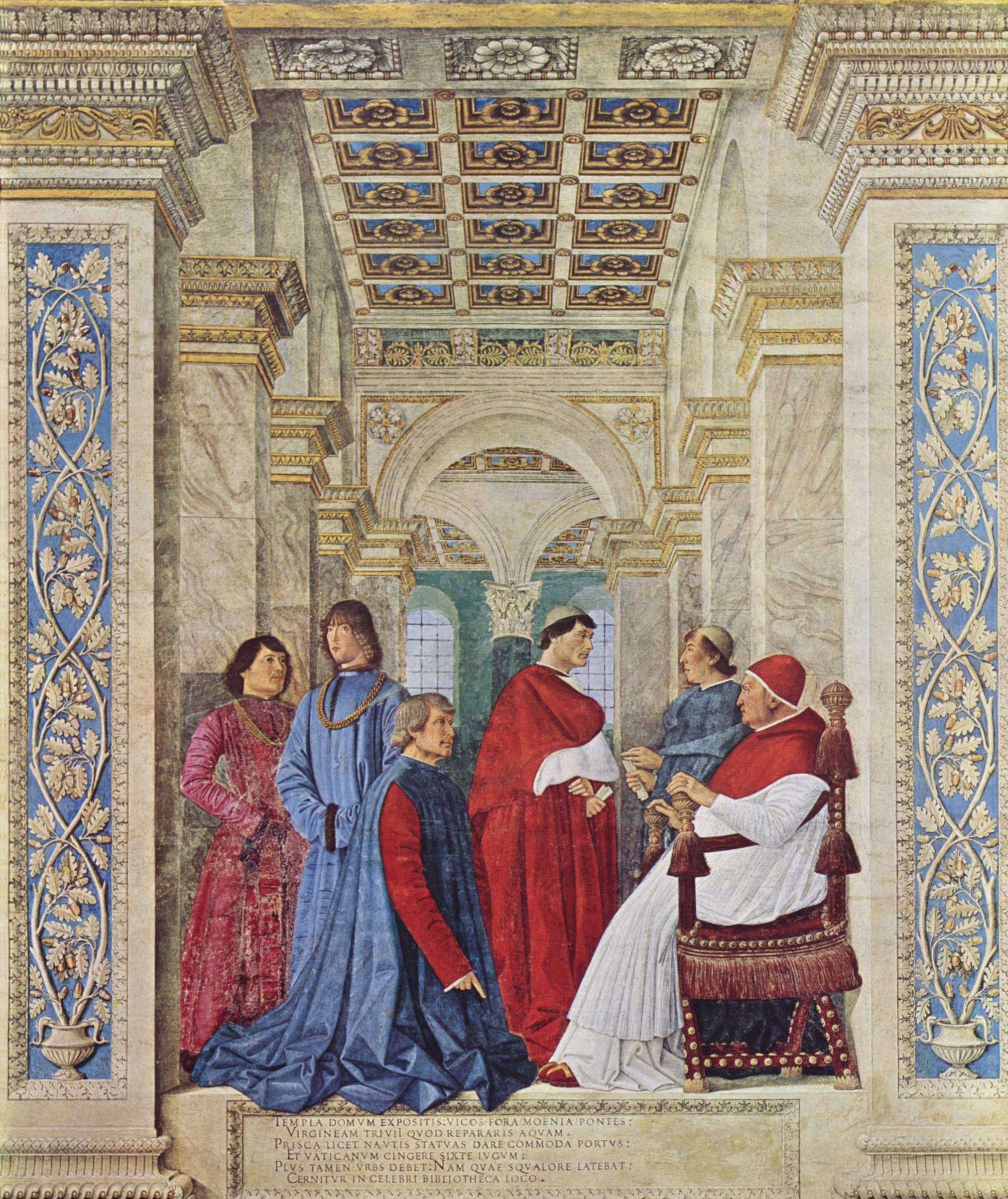d. August 12, 1484
Pope Sixtus IV appoints Platina as Prefect of the Library, by Melozzo da Forlì
Sixtus IV (r. 1471-1484), born Francesco della Rovere, was notable enough to have the Sistine Chapel named after him. Like Julius III with Innocenzo, Sixtus made his lover Petro Riario - who was also his nephew - a cardinal. According to Crompton, this time writing in his monumental history Homosexuality and Civilization, Sixtus was labeled a “sodomite” in the dispatches of the Venetian ambassador and the diaries of Vatican insiders Stefano Infessura and Johann Burchard. Another nephew, Giuliano della Rovere, later achieved infamy as the “terrible pope” Julius II (1503-1513), Sixtus IV (1414-1482), is remembered for his art patronage, which included the erection and first decorations of the Sistine chapel. Among the artists most prominent in his reign was the Florentine homosexual Botticelli.This pope favored his scheming nephews, one of whom himself became pope under the name of Julius II. However, Sixtus was most devoted to another nephew, Raffaele Riario, whom he made papal chamberlain and bishop of Ostia. He elevated to the cardinalate a number of other handsome young men.
Both within Catholic and Protestant circles, there were widely spread rumors about the homosexual liaisons of Sixtus IV (Francesco Della Rovere, 1414-84; reigned 1471-84); many of these were recorded by the chronicler Stefano Infessura (c. 1440-1500). Among the young men whom Sixtus is supposed to have favored is Giovanni Sclafenato (d. 1497), whom he appointed Cardinal and bishop of Parma. The inscription on Sclafenato's tomb in Parma Cathedral--declaring that he was appointed Cardinal because of "his loyalty, industry, and other gifts of the spirit and the body"--lends support to allegations that his physical endowments helped to inspired the favors that the Pope extended to him.
Despite the scandalous rumors spread about his personal conduct, Sixtus was an effective leader, and he succeeded both in strengthening the temporal power of the Catholic Church and in halting temporarily the advances of Protestantism. He is responsible for establishing as dogma several fundamental aspects of Catholic belief, including the sanctity of Christ before the Resurrection.
Today, he is perhaps best remembered as an outstanding patron of the arts; he was responsible for initiating the physical rehabilitation of the city of Rome, which was continued by pontiffs in the early sixteenth century. He undertook the construction of the Sistine Chapel (1471-80) and the decoration of its walls (1481-2) with frescoes of biblical scenes by leading artists of the day, including Pietro Perugino, Sandro Botticelli, Domenico Ghirlandaio, and Cosimo Rosselli.
From Wikipedia:
Sixtus IV has been accused of having had male lovers, the basis of this being the diary records of Stefano Infessura who recorded documented episodes, but also unsubstantiated rumours. He was accused of awarding benefices and bishoprics in return for sexual favours, and nominated a number of young men as cardinals, some of whom were celebrated for their looks. While it is indisputable that Sixtus favoured his relatives in the hope of having faithful executors of policy; there is less evidence of direct corruption or favouritism. The exception may perhaps be Giovanni Sclafenato, who was created a cardinal according to the papal epitaph on his tomb for "ingenuousness, loyalty and his others gifts of soul and body". The English theologian John Bale attributed to Sixtus "the authorisation to practice sodomy during periods of warm weather". However, such accusations by Protestant polemicists can be dismissed as attempts at anti-Catholic propaganda.
Related Posts:

No comments:
Post a Comment